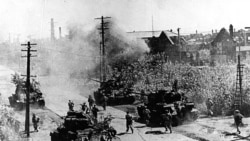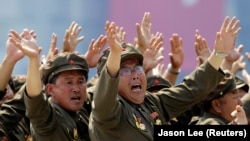July 27 marked the 69th anniversary of the signing the Korean War armistice between military commanders from the U.S.-led United Nations forces, North Korea and China.
During the 1950-1953 war on the peninsula, the People’s Republic of China backed North Korea with help from the Soviet Union, while U.S.-led U.N. forces defended South Korea.
The armistice, which South Korea refused to sign, brought a cease-fire in lieu of a peace deal ending the war. Tensions have remained high between the two Koreas ever since.
Last week, China commemorated the armistice’s anniversary by claiming victory in what it calls “the War to Resist the U.S. Aggression and Aid Korea.”
A 29-second video posted on China’s Twitter-like site Weibo, with the hashtag “we won the War to Resist the U.S. Aggression and Aid Korea 69 years ago today,” garnered nearly 12.5 million views. State accounts, including the Chinese Communist Youth League, widely shared the video.
The video proclaimed:
“[China’s victory in] the great War to Resist the U.S. Aggression and Aid Korea resisted the imperialist invasion and expansion, safeguarded the security of the New China, defended the peaceful life of the Chinese people, stabilized the situation on the Korean Peninsula and preserved peace in Asia and the world.”
That sweeping characterization is misleading.
In fact, the U.S. was not the aggressor. The Korean War broke out when Soviet-backed North Korea launched a full-scale invasion of the south on June 25, 1950. Some 75,000 North Korean People’s Army soldiers marched across the 38th parallel boundary that divided the Koreas.
Korea was a colony of Imperial Japan from the start of the 20th century to the end of World War II. After the war the United States proposed temporarily dividing the country along latitude 38 degrees north. The Soviets occupied the northern half, and Americans occupied the south.
In 1948, the U.S.-backed Republic of Korea (ROK) was declared in the south, with Seoul as its capital, and Syngman Rhee, who had been brought back to South Korea by the U.S. military in 1945, was elected the ROK’s president by its Constituent National Assembly.
That same year, the Soviet-backed Democratic People’s Republic of Korea (DPRK) was declared in the north, with its capital in Pyongyang. The DPRK was led by Moscow-installed Kim Il Sung, the grandfather of North Korea’s current leader Kim Jong Un.
Kim ruled the north as a communist dictatorship, and Rhee also became increasingly authoritarian as the south’s ruler. Both sought to unify the peninsula by force and declared themselves as the sole rightful leader of a unified Korea.
“[B]order skirmishes were common,” wrote History.com. “Nearly 10,000 North and South Korean soldiers were killed in battle before the war even began.”
The day Pyongyang launched its invasion, the U.N. Security Council passed Resolution 82 calling on North Korea to cease hostilities and withdraw. After that was ignored, the council passed resolutions asking U.N. members to help “repel the attack and restore peace.”
The council authorized a U.N. command led by U.S. Gen. Douglas MacArthur and 15 other countries, including the United Kingdom, France, Australia, Canada, Turkey and Ethiopia.
“While there is much to criticize about the behavior of ever-belligerent and irresponsible South Korean President Syngman Rhee, he was the one surprised on June 25, 1950 – and would have been ousted if it weren’t for the swift American intervention,” Doug Bandow, a former special assistant to U.S. President Ronald Reagan, wrote in Foreign Policy magazine in 2020.
According to History.com, “the North Korean invasion came as an alarming surprise to American officials.”
In another article published by History.com, journalist Jesse Greenspan wrote that at the time of the North Korean invasion, the U.S. was focused on the European front of the Cold War with the Soviet Union and “appeared disinclined to intervene” in Korean affairs.
“The year before, it had removed its last remaining troops from Korea,” wrote Greenspan. “[A]nd that January, U.S. Secretary of State Dean Acheson had given a speech in which he excluded Korea from America’s defense perimeter.”
That changed with the invasion.
“If we let Korea down, the Soviet[s] will keep right on going and swallow up one piece of Asia after another,” said then-U.S. President Harry Truman.
Declassified Soviet archives revealed that then-Soviet dictator Joseph Stalin had given Kim Il Sung a “green light” to attack South Korea.
A declassified August 27, 1950, telegram from Stalin to Czechoslovak President Klement Gottwald further revealed the Soviet dictator’s thinking. “It is clear that the United States of America is presently distracted from Europe in the Far East,” Stalin wrote. “Does it not give us an advantage in the global balance of power? It undoubtedly does.”
Commenting on the telegram, historians Donggil Kim of Beijing University and William Stueck Jr. at the University of Georgia wrote:
“Stalin apparently had strong hopes for China's intervention in Korea. Stalin commented to Gottwald what he believed the outcome of the Korean War would be if China was ‘[pulled]…into the struggle for the freedom of Korea.’
“It seems that Stalin's aim in the Korean War depended upon Chinese intervention, believing that Chinese intervention would not only tie down the United States in conflicts in Asia, but also weaken the United States' overall stature and influence.”
As the U.S.-led U.N. troops pushed North Korean troops back north of the 38th parallel and moved closer to the Yalu River and the North-Korean-Chinese border, China’s communist dictator Mao Zedong sent hundreds of thousands of Chinese fighters to aid North Korea.
“The Soviet Union supported North Korea at the beginning of the war, giving it arms, tanks and strategic advice. But China soon emerged as its most important ally, sending soldiers to fight in Korea as a way to keep the conflict away from its border,” The New York Times wrote in 2018.
Historians continue to debate the motives behind Mao’s intervention in Korea – ranging from security concerns, a desire to please Stalin to China’s own expansionist tendencies.
The Chinese troops succeeded in forcing the U.S.-led troops to retreat. Beijing says that fewer than 200,000 Chinese soldiers died in the Korean War, but U.S. historian Bruce Cumings estimated that China lost approximately 900,000 men, citing encyclopedias. (Other estimates are here.)
Following the retreat of the U.S.-led U.N. forces the Truman administration, unwilling to be dragged deeper into a war in Asia, “abandoned its goal of unifying Korea and expressed its willingness to negotiate with the communists,” wrote Greenspan.
MacArthur sought permission for an “all-out” offensive against China and communism but was turned down by Truman, who fired the general for defying his orders. “We are trying to prevent a world war – not to start one,” Truman said about his decision.
Cease-fire negotiations began in July 1951 and lasted two years.








